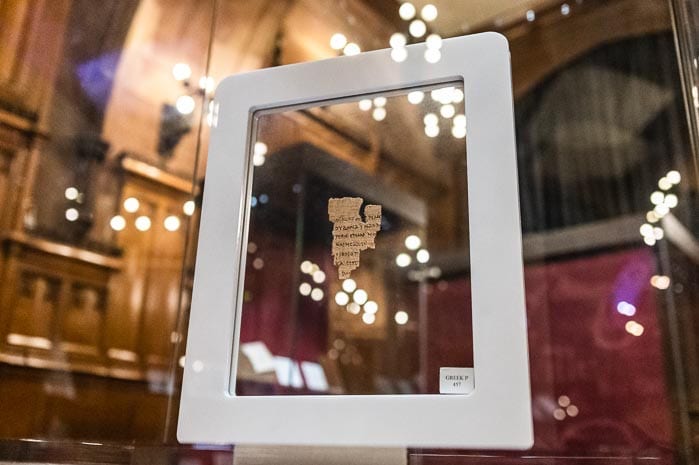The tiny object that launched the rise of Christianity in Manchester
- Written by Ed Glinert
- Last updated 1 year ago
- Cornerstone, Culture, History

With the accidental discovery of a Roman relic beneath the Beetham Tower, we learned how Christians were almost certainly present in Roman Manchester around 180 AD, long before Rome became Christian.
So it is fitting that Manchester is home to the oldest piece of the New Testament ever discovered.
The St John Fragment is a tiny piece of papyrus just three inches high, a codex not a scroll, handwritten in Classical Greek on both sides.
It was discovered at Oxyrhynchus (also known as Behnesa), the ruined city in Upper Egypt, and acquired on the Egyptian market in 1920 by Bernard Grenfell, Professor of Papyrology at Oxford.
Handwriting experts initially placed the writing at around 125 AD, but later research puts it nearer 200. It can’t be carbon dated for it would fall apart.
The text comes from St John’s Gospel, Chapter 18, verses 31-33 on one side, with parts of verses 37-38 on the other side. The King James Bible translation from the section reads:
31 Pilate therefore said to them: Take him you, and judge him according to your law. The Jews therefore said to him: It is not lawful for us to put any man to death;
32 That the saying of Jesus might be fulfilled, which he spake, signifying what death he should die.
33 Then Pilate entered into the judgment hall again, and called Jesus, and said unto him, Art thou the King of the Jews?
••••
37 Pilate therefore said unto him, Art thou a king then? Jesus answered, Thou sayest that I am a king. To this end was I born, and for this cause came I into the world, that I should bear witness unto the truth. Every one that is of the truth heareth my voice.
38 Pilate saith unto him, What is truth? And when he had said this, he went out again unto the Jews, and saith unto them, I find in him no fault at all.
The relic was sent to John Rylands Library but not catalogued for 15 years when papyrus collections were finally sorted. It is now on display in the Rylands Gallery of the Library.
To find out more about the history of the city through its sites, signs, symbols, statues, settings, join tour guide and author Ed Glinert on one of his New Manchester Walks. More information on the website.
- This article was last updated 1 year ago.
- It was first published on 8 February 2019 and is subject to be updated from time to time. Please refresh or return to see the latest version.
Did we miss something? Let us know: press@ilovemanchester.com
Want to be the first to receive all the latest news stories, what’s on and events from the heart of Manchester? Sign up here.
Manchester is a successful city, but many people suffer. I Love Manchester helps raise awareness and funds to help improve the lives and prospects of people across Greater Manchester – and we can’t do it without your help. So please support us with what you can so we can continue to spread the love. Thank you in advance!
An email you’ll love. Subscribe to our newsletter to get the latest news stories delivered direct to your inbox.
Got a story worth sharing?
What’s the story? We are all ears when it comes to positive news and inspiring stories. You can send story ideas to press@ilovemanchester.com
While we can’t guarantee to publish everything, we will always consider any enquiry or idea that promotes:
- Independent new openings
- Human interest
- Not-for-profit organisations
- Community Interest Companies (CiCs) and projects
- Charities and charitable initiatives
- Affordability and offers saving people over 20%
For anything else, don’t hesitate to get in touch with us about advertorials (from £350+VAT) and advertising opportunities: advertise@ilovemanchester.com


Review: Tambo & Bones at HOME is ‘ambitious, bold, gutsy…. and terrific’

Review: JB Shorts 26 at 53two is ‘a five-star showcase of northern talent’


















